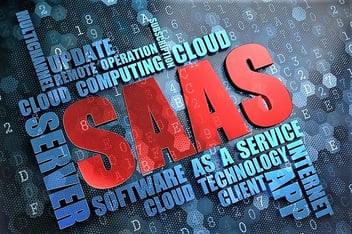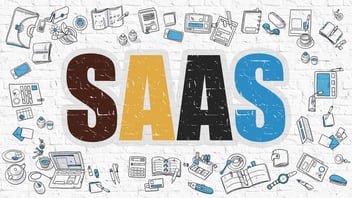Software as a Service, or SaaS, has seen huge proliferation in the past decade.
Research by Martech Today found that in 2017 there were over 5,000 providers in the marketing technology space, compared to around 150 in 2011. It’s an exciting time to be in the industry, with innovation, and quality and quantity of features continuing apace.
This article explores SaaS marketing trends in 2018. Key themes are hyperspecialization, proliferation, integration and, of course, artificial intelligence. To foster a tone of positivity, we’ve included more dos than don’ts. Let’s begin.
Do expect SaaS providers to focus on providing ‘on top’ services, as well as the traditional horizontal and vertical.
Definitions
- Horizontal SaaS software is industry-neutral, and caters for a need that exists across many industries. Examples include finance, invoicing and time management products.
- Vertical SaaS software is industry-specific, catering for needs that exist within that industry. Example industries include finance, pharmaceutical and legal.
- On top SaaS software is designed to integrate with (an) existing solution(s). The benefits of on top SaaS are intriguing: for providers, they are able to tap into an established and receptive customer base; for customers, they are able to enjoy more effective integration between currently disparate software products.
Do expect to hear more about Platform as a Service (PaaS). This is more than just another acronym to remember: PaaS refers to the ‘ecosystems’ created by combining horizontal, vertical and on top solutions. As the industry explores combinations and the most useful ones become apparent, pre-made combinations will begin to be offered as platforms.
Do expect higher quality service from SaaS providers, as they aim to distinguish themselves from the ever-increasing crowd.
Do expect continued provision of new features by familiar providers, for the same reason as above. Innovation and exploration mean that SaaS is an exciting area to be involved with in 2018 and onwards.
Do expect artificial intelligence (AI) to constitute part of these new features. AI is moving from a generic industry buzzword to a tangible concept with tangible applications.
Do expect more targeted customer service to be the guiding factor for these new features, and for AI to allow this to happen. We expect that pop-ups, generic landing pages and other prospective marketing efforts will begin to lose popularity as AI enables businesses to analyse and understand specific customer needs, and target lead-generation efforts accordingly.
Do expect a desire for immediacy from customers, both potential and existing, to be another guiding factor in improved customer service and lead conversion metrics. The days of emailing a faceless support email account with a question and waiting 2-5 days for a response are closing; customers now expect quick and custom answers. Live chats and chatbots are good examples of how such answers can be provided, and AI is increasingly seen as a viable way to power these channels.
Do expect increased mobile SaaS to provide a wider suite of apps and services for mobile platforms, in line with continued increases in mobile usage. In 2017, 75% of respondents to an Ofcom survey said they frequently use mobile devices, compared to 66% for laptop, 52% for tablet and only 39% for desktop.
Do expect industry buzzwords to continue shifting, as exciting new concepts are explored and integrated into the current SaaS offering. Machine learning and AI are our predicted big buzzwords for 2018, and blockchain is a bonus sneak-peek at our 2019 list.
Definitions
- Mobile: a catch-all term for non-desktop devices, including smartphones and tablets. Mobile marketing acknowledges the large and increasing number of users, and aims to capture their attention via tailored marketing efforts for these devices. Examples include SMS, apps, responsively designed websites for mobile, and geotargeting.
- Machine learning: an exciting buzzword around 2015/16, machine learning is the ability for computers to learn without being explicitly programmed. It has implications in more efficient analysis of data, automated data visualisation, and improved analysis of features of effective content.
- Artificial intelligence: Wikipedia defines AI as “any device that perceives its environment and takes actions that maximise its chance of successfully achieving its goals”. In marketing this has exciting implications, especially as budgets and uptake increase the amount of research and experimentation.

These predictions represent exciting and positive opportunities for the SaaS space, we’re sure you’ll agree. There are a couple of things not to expect, too:
Don’t expect to see as many completely unique services arising, either from new providers or as new services from existing ones. The proliferation in services and providers we mentioned means that the focus is now moving toward doing existing things as effectively and efficiently as possible.
Don’t get hung up on exploration. Increased proliferation means an ever-growing pool of providers to explore when looking for SaaS services, and this can quickly become overwhelming. If you’re experiencing decision fatigue when looking for a provider, look to industry influencers and publications whose opinions may help you to narrow down your choices.
We’re not sure which way this one will go so we’ve left it for last. Will the proliferation boom continue, or will it begin to whittle itself down?
Innovation can only continue for so long before the marketplace selects its favourites. Think about how the explosion in apps slowed down to reveal users’ favourites, or how the boom in craft beer is beginning to show a few breweries as the ‘standard’ selection in bars. While new and niche products will always exist, the visible ‘norms’ will eventually be established.
What do you predict for 2018 in SaaS? Do you agree with our predictions, or have we got it completely wrong?





